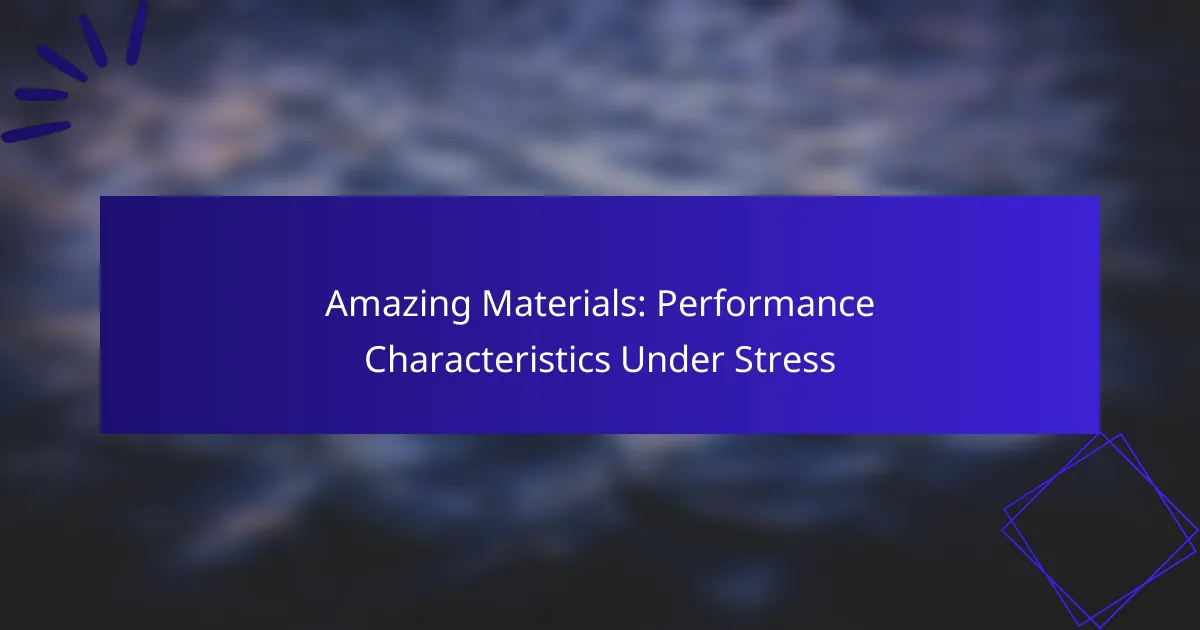In high-stress applications, selecting the right material is critical for ensuring performance and durability. Materials like carbon fiber, Kevlar, and aluminum alloys offer unique properties that cater to specific demands, balancing strength, weight, and cost. Additionally, understanding how materials respond to tensile stress and temperature variations is essential for optimizing their use in challenging environments.

What are the best materials for high-stress applications?
The best materials for high-stress applications include carbon fiber, Kevlar, aluminum alloys, steel composites, and thermoplastics. Each material has unique properties that make it suitable for specific high-stress environments, balancing factors like strength, weight, and cost.
Carbon fiber
Carbon fiber is renowned for its high strength-to-weight ratio, making it ideal for applications where minimizing weight is crucial, such as in aerospace and automotive industries. It can withstand significant stress without deforming, but it is also more expensive than traditional materials.
When using carbon fiber, consider its brittleness; while it is strong under tension, it can be susceptible to impact damage. Proper layering and resin choices can enhance its durability.
Kevlar
Kevlar is a synthetic fiber known for its exceptional tensile strength and resistance to abrasion, making it a popular choice for protective gear and military applications. Its ability to absorb energy helps it perform well under dynamic stress conditions.
However, Kevlar is not as rigid as carbon fiber, which may limit its use in structural applications. It is often combined with other materials to enhance performance in specific contexts, such as in composite panels.
Aluminum alloys
Aluminum alloys offer a good balance of strength, weight, and corrosion resistance, making them suitable for a variety of high-stress applications, including automotive and aerospace sectors. They are relatively easy to work with and can be formed into complex shapes.
When selecting aluminum alloys, consider the specific alloy grade, as some provide better strength or corrosion resistance than others. Common choices include 6061 and 7075, which are widely used for their favorable properties.
Steel composites
Steel composites combine the strength of steel with other materials to enhance performance under stress. This can include layering steel with polymers or ceramics to improve impact resistance and reduce weight.
While steel composites can be more expensive than traditional steel, they often provide superior performance in demanding environments. It’s essential to evaluate the specific application to determine if the benefits justify the cost.
Thermoplastics
Thermoplastics are versatile materials that can be molded and reshaped, offering good impact resistance and flexibility under stress. They are increasingly used in automotive and consumer products due to their lightweight nature and ease of processing.
When considering thermoplastics, be aware of their temperature sensitivity; they can lose strength at elevated temperatures. Selecting the right type, such as polycarbonate or nylon, can help mitigate this issue for specific applications.

How do materials perform under tensile stress?
Materials under tensile stress exhibit specific performance characteristics that determine their suitability for various applications. Key factors include yield strength, ultimate tensile strength, and elongation at break, which collectively indicate how a material will react when stretched or pulled.
Yield strength
Yield strength is the maximum stress that a material can withstand while still returning to its original shape once the stress is removed. It marks the transition from elastic deformation to plastic deformation, where permanent changes occur. For many metals, yield strength can range from a few hundred megapascals (MPa) to over a thousand MPa, depending on the alloy and treatment.
When selecting materials for construction or manufacturing, consider yield strength to ensure that the material can handle expected loads without permanent deformation. Always refer to material specifications and standards to determine the appropriate yield strength for your application.
Ultimate tensile strength
Ultimate tensile strength (UTS) is the maximum stress a material can endure before failure, indicating its overall strength. UTS values vary widely among materials; for example, steel typically has a UTS of around 400 to 2,000 MPa, while polymers may range from 20 to 100 MPa. Understanding UTS is crucial for applications where materials are subjected to high stress.
When designing components, ensure that the UTS exceeds the maximum expected load to prevent catastrophic failure. A safety factor is often applied, typically ranging from 1.5 to 3 times the expected load, depending on the application and material properties.
Elongation at break
Elongation at break measures how much a material can stretch before it fractures, expressed as a percentage of its original length. This property is vital for materials that need to absorb energy or undergo significant deformation without breaking. For instance, ductile materials like certain steels can have elongation values of 10% to 50%, while brittle materials may have values below 5%.
When selecting materials for applications requiring flexibility or impact resistance, prioritize those with higher elongation at break. This characteristic can help prevent sudden failures and improve the durability of components under dynamic loads.

What are the effects of temperature on material performance?
Temperature significantly influences material performance, affecting properties such as strength, ductility, and thermal stability. Understanding these effects is crucial for selecting materials in applications where temperature fluctuations are expected.
Thermal expansion
Thermal expansion refers to the tendency of materials to change in size or volume when exposed to temperature variations. Most materials expand when heated and contract when cooled, which can lead to stresses in structures if not properly accounted for.
For example, metals typically have a higher coefficient of thermal expansion compared to ceramics. Engineers must consider these differences when designing components that will experience temperature changes, ensuring adequate spacing and support to accommodate movement.
Heat resistance
Heat resistance is the ability of a material to withstand high temperatures without significant degradation of its properties. Materials like ceramics and certain alloys are designed to maintain their strength and stability at elevated temperatures.
When selecting materials for high-temperature applications, consider the maximum service temperature and the duration of exposure. For instance, some polymers can lose structural integrity at temperatures above 100°C, while specialized metals can endure temperatures exceeding 1000°C.
Phase changes
Phase changes occur when materials transition between solid, liquid, and gas states due to temperature variations. These changes can significantly affect material performance, as properties like strength and density can vary dramatically between phases.
For example, water expands when it freezes, which can cause structural damage in confined spaces. Understanding phase diagrams can help predict how materials will behave under different thermal conditions, aiding in the selection of appropriate materials for specific applications.

How do different materials compare under compressive stress?
Different materials exhibit varying performance characteristics under compressive stress, which is the force that tends to compress or shorten the material. Understanding these differences is crucial for selecting the right material for construction and manufacturing applications.
Concrete vs. steel
Concrete and steel are two of the most commonly used materials in construction, each with unique properties under compressive stress. Concrete is strong in compression, typically withstanding pressures of around 20 to 40 MPa, but it is weak in tension. Steel, on the other hand, has a much higher tensile strength and can endure compressive stresses exceeding 250 MPa.
When choosing between concrete and steel, consider the application. For structures requiring high tensile strength, such as beams and columns, steel is often preferred. However, for foundations and walls where compressive strength is paramount, concrete is typically the better choice.
Wood vs. composites
Wood is a natural material that performs well under compressive stress, with values ranging from 40 to 80 MPa depending on the species. However, its performance can be inconsistent due to knots and grain direction. Composites, which combine materials like wood fibers with resins, can enhance strength and uniformity, often achieving compressive strengths above 100 MPa.
When selecting between wood and composites, consider durability and environmental factors. Composites may offer better resistance to moisture and pests, making them suitable for outdoor applications, while wood can provide aesthetic value and is often more sustainable.
Polymer blends
Polymer blends are engineered materials that combine different types of polymers to enhance performance characteristics, including compressive strength. These blends can achieve compressive strengths ranging from 30 to 100 MPa, depending on the formulation and additives used.
When working with polymer blends, consider their application environment. They are often used in lightweight applications where corrosion resistance is crucial, such as in automotive and aerospace industries. Ensure that the selected blend meets the specific performance requirements for the intended use.

What factors influence material selection for engineering projects?
Material selection for engineering projects is influenced by several key factors, including cost-effectiveness, availability, and environmental impact. These factors help engineers determine the most suitable materials that meet project requirements while balancing performance and sustainability.
Cost-effectiveness
Cost-effectiveness is a critical factor in material selection, as it directly impacts the overall budget of a project. Engineers must evaluate both the initial costs of materials and their long-term maintenance expenses. For example, while high-performance composites may have a higher upfront cost, their durability can lead to lower maintenance costs over time.
When assessing cost, consider the total lifecycle cost, which includes procurement, installation, maintenance, and disposal. This approach ensures that the selected materials provide value throughout their use.
Availability
Material availability is essential for timely project completion. Engineers should assess local supply chains to ensure that chosen materials can be sourced without significant delays. For instance, materials that are readily available in a region may reduce lead times and transportation costs.
It is also important to consider the potential for future shortages or price fluctuations. Using materials with stable supply chains can mitigate risks associated with project timelines and budgets.
Environmental impact
The environmental impact of materials is increasingly important in engineering projects. Selecting materials with lower carbon footprints and sustainable sourcing practices can enhance a project’s overall sustainability. For example, using recycled materials or those that are locally sourced can significantly reduce environmental impact.
Engineers should also be aware of regulations and standards related to environmental sustainability in their region. Compliance with these guidelines not only supports eco-friendly practices but can also improve public perception and marketability of the project.

How do manufacturers test material performance?
Manufacturers test material performance through a variety of methods designed to evaluate how materials behave under stress. These tests help determine durability, strength, and other critical characteristics that influence material selection for specific applications.
Standardized testing methods
Standardized testing methods provide a consistent framework for evaluating material performance. These methods, often governed by organizations such as ASTM International or ISO, ensure that tests are repeatable and comparable across different laboratories and manufacturers.
Common standardized tests include tensile strength tests, impact tests, and fatigue tests. For example, tensile tests measure how much a material can stretch before breaking, while impact tests assess how materials withstand sudden forces. Each method has specific procedures and criteria that must be followed to ensure accuracy.
When selecting a testing method, consider the material type and its intended application. For instance, metals may require different tests than polymers. Understanding the appropriate standards can help avoid costly mistakes and ensure that the material meets necessary performance criteria.
